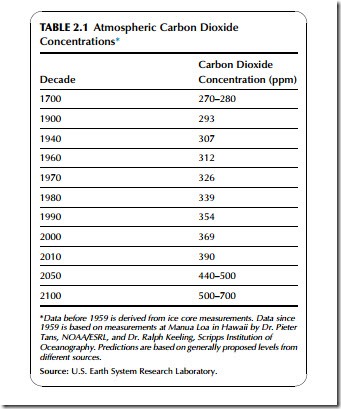CARBON CYCLE AND ATMOSPHERIC WARMING
The combustion of fossil fuels such as coal, oil, and natural gas releases significant quantities of carbon dioxide into the atmosphere. These fuels were created from organic material growing on Earth’s surface that became buried, locking the carbon they contained within the body of the planet. Since the Industrial Revolution the use of these fuels has accelerated. The consequence appears to have been a gradual but accelerating increase in the concentration of carbon dioxide within Earth’s atmosphere.
Before the Industrial Revolution the concentration of carbon dioxide in the Earth’s atmosphere was around 270–280 parts per million (ppm). Between 1700 and 1900 there was a gradual increase in atmospheric concentrations but from 1900 onwards, the concentration changed more rapidly, as shown in Table 2.1. From 1900 to 1940 atmospheric carbon dioxide increased by around 10 ppm
from 1940 to 1980 it increased by 32 ppm, and by 2000 it had increased by a further 30 ppm. In 2010 the concentration was 21 ppm higher than in 2000. By then the total concentration was 390 ppm, around 40% higher than in 1700.
If the increase in carbon dioxide concentration is a direct result of the combustion of fossil fuels, then it will continue to rise until that combustion is curbed. Estimates of future concentrations are at best speculative, but Table 2.1 includes a range of estimates for both 2050 and 2100. The worst case in the table shows concentrations doubling in 100 years.
While the increase in carbon dioxide concentration is clear and continuous, the increase in global temperature is more variable. The evidence for a fossil fuel connection with the increase in concentration of carbon dioxide is compel- ling, but the cycling of carbon among the atmosphere, sea, and biosphere is so complex that it is impossible to be certain how significant the human-made changes are, or what other factors may be involved.
The atmospheric emissions of carbon from human activities such as the combustion of coal, oil, and natural gas amounted to a total of around 8.6 Gtonnes in 2012. While this is an enormous figure, it is tiny compared to the total carbon content of 750 Gtonnes in the atmosphere. This atmospheric carbon is part of the global carbon cycle. There are roughly 2200 Gtonnes of carbon contained in vegetation, soil, and other organic material on Earth’s sur- face, 1000 Gtonnes in the ocean surfaces, and 38,000 Gtonnes in the deep oceans.
The carbon in the atmosphere, primarily in the form of carbon dioxide, is not static. Plants absorb atmospheric carbon dioxide during photosynthesis, using the carbon as a building block for new molecules. Plant and animal respiration, on the other hand, part of a natural process of converting fuel into energy, releases carbon dioxide to the atmosphere. As a result there are probably around 60 Gtonnes of carbon cycled between vegetation and the atmosphere each year, while an additional 100 Gtonnes are cycled between the oceans and the atmosphere by a process of release and reabsorption. Thus, the cycling of carbon between the atmosphere and Earth’s surface is a complex exchange into which the human contribution from fossil fuel combustion is small.
The actual significance of the additional release of carbon dioxide resulting from human activity depends on the interpretation of various scientific observations. The most serious of these relate to a slow increase in temperature at Earth’s surface. This has been attributed to the greenhouse effect, whereby car- bon dioxide and other gases in the atmosphere allow the sun’s radiation to penetrate the atmosphere but prevent heat leaving, in effect acting as a global insulator.
If human activity is responsible for global warming, then unless carbon dioxide emissions are controlled and eventually reduced, the temperature rise will continue and probably accelerate. This will lead to a number of major changes to conditions around the globe. The polar ice caps and glaciers will melt, leading to rises in sea level, which will inundate many low-lying areas of land. Climate conditions will change. Plants will grow more quickly in a car- bon dioxide–rich atmosphere.
Not all scientists agree that changes in our practices can control the global changes. There have been large changes in atmospheric carbon dioxide concentrations in the past, and large temperature swings. It remains plausible, though unlikely given the weight of evidence now available, that both carbon dioxide concentration changes and global temperature changes are part of a natural cycle and that the human contribution has little influence.
In the second decade of the 21st century the weight of the scientific evidence suggests a strong link between human release of carbon dioxide and global warming, but it may be impossible to find absolutely conclusive proof. Unfortunately, the nature of scientific inquiry will always leave open the possibility, however remote, of an alternative interpretation. But in the meantime conditions will continue to change. And if human activity is responsible, the change may eventually become irreversible.
Even if a link between an increase in carbon dioxide concentration and the rising global temperature cannot be made with absolute certainty, it is clear that combustion of fossil fuel is creating more carbon dioxide than would naturally have entered the atmosphere. This fact itself provides a powerful reason to act to slow and eventually reverse the release of the gas. However, there are also eco- nomic considerations and these are generally not in favor of any rapid adjust- ment. How the competing demands are balanced is likely to determine the fate of the globe.